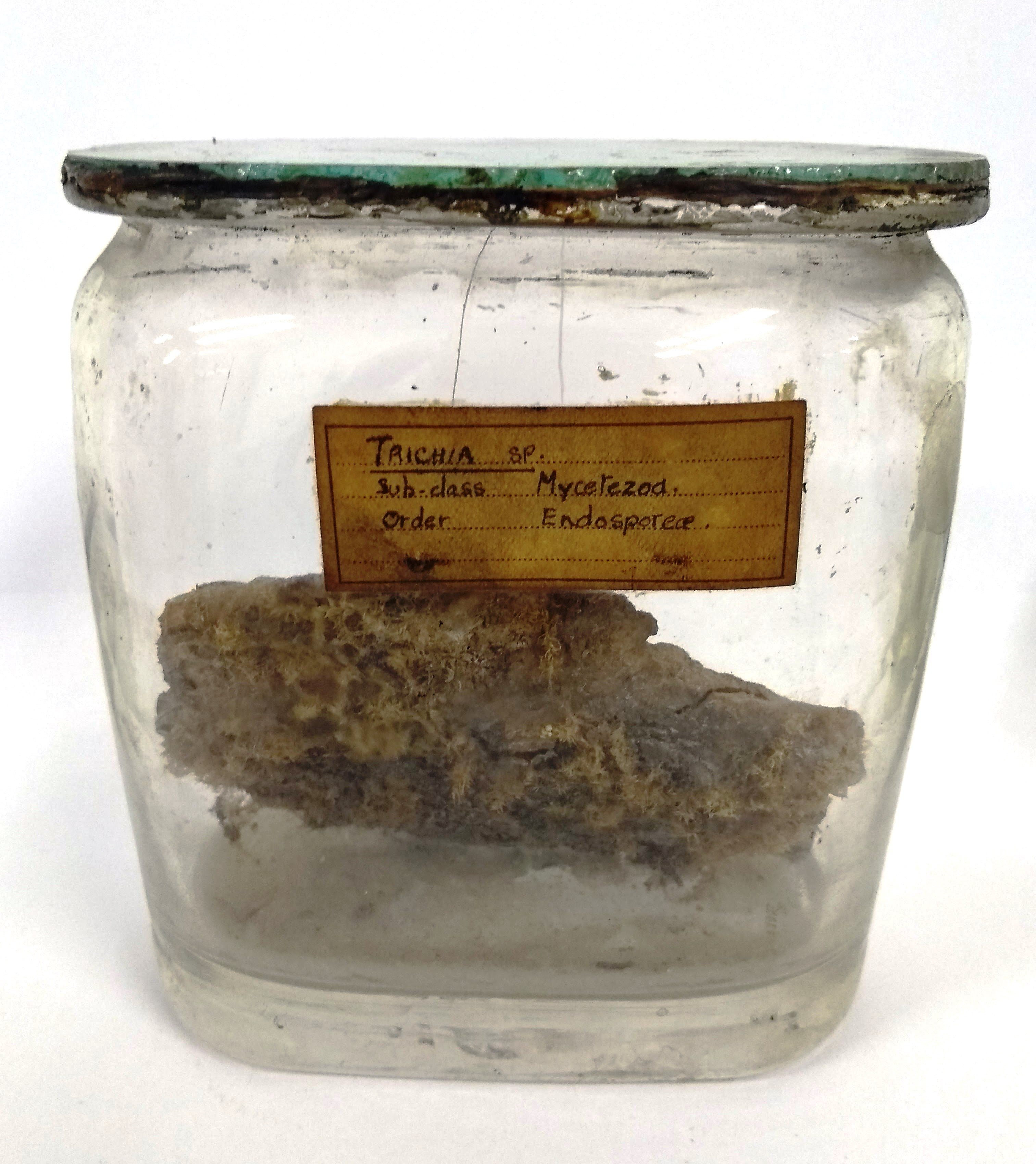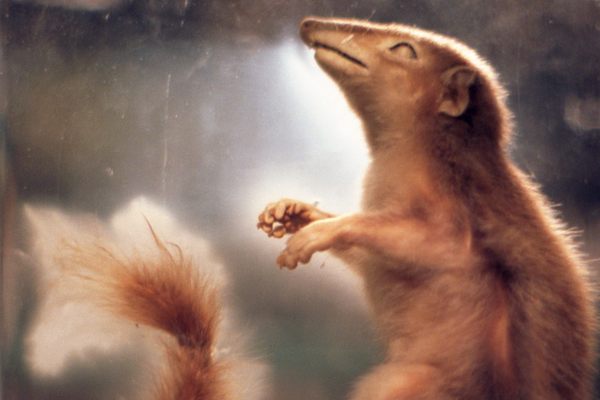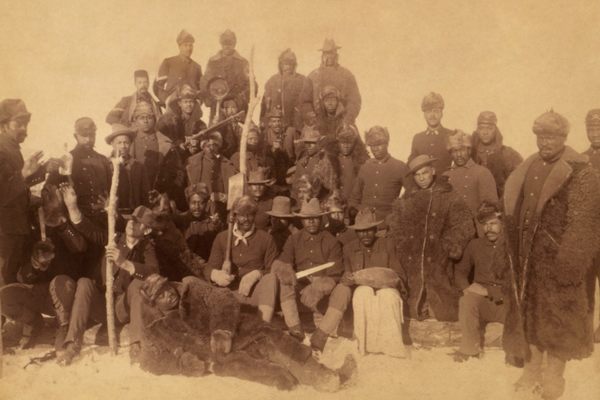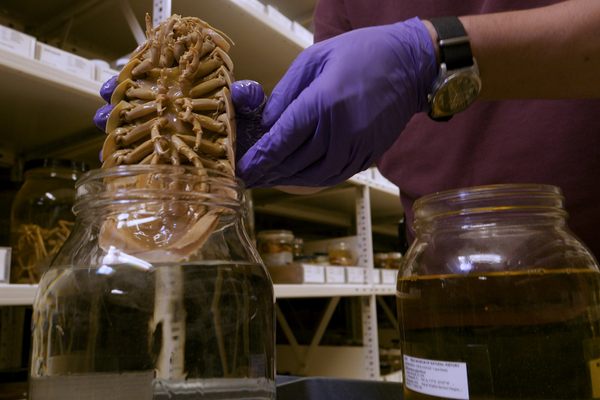A Researcher’s Quest to Decode the Specimens on a Museum’s Mystery Shelf
Sifting through the old, unlabeled, puzzling jars that fill a collection’s junk drawer.

By the time a natural history museum puts an articulated skeleton, pressed flower, or preserved fish on display, the staff surely knows a lot about it: what it is, where it came from, what it’s made of. But that’s not always the case behind the scenes and in storage rooms. These facilities can serve as a museum’s junk drawer, and may hold a hodgepodge of objects that have been misplaced, overlooked, or unidentified. There might be some interesting specimens in there, either for research or display, but it is impossible to tell until someone sifts through the stacks and tidies things up.
That’s what Hannah Cornish will be doing over next few months. An assistant curator at the Grant Museum of Zoology in London, she has set out to take stock of some of the 5,000 specimens housed in what they call the wet storage facility, a chilly basement room packed with 26 shelving units. Each of those is crowded with items, most in a bewildering variety of glass jars filled with liquid in a range of colors.

Cornish plans to focus on the storage room’s 1,000 vertebrate-related specimens. Most of them are pretty well-labeled and organized, she says—marsupials with marsupials, cats with other cats. But then there is a shelf labeled “Miscellaneous.” That’s where the problem cases have been stashed over the years by busy curators who simply didn’t have the time to probe the little mysteries they posed. Some of these specimens are minuscule, such as tiny vials full of marine crustaceans that will only come into focus under a microscope. Others, such as an unidentified organ filling a jar nearly a foot tall, are no less elusive for being so substantial. Cornish has already encountered a handful of head-scratchers.

The puzzles presented by the arrayed jars range from the practical (Does the label match our database?) to the more existential (Is this what it claims to be?). Labels are so important for making sense of what is in a museum, and include information about provenance, identification of the contents, and age. But these can fade or fall off, or may have been wrong in the first place. Initial interpretations—even if they had been accurate at the time—may also be due for revisions in light of newer research. Some other things probably shouldn’t have been collected at all, or were just jokes in the first place.
When jar labels are illegible, it becomes very hard to know what’s inside—especially if the contents are degraded or the preservative solution has grown cloudy. Sometimes Cornish can compare a fragment of an accession number against a handwritten registry. For example, she was able to match an unidentified brain specimen to a number in the margin of one register stretching back to 1935. That’s how she learned it had come from a seal.
She needed digital databases to help crack the mystery of a pair of lumpy organs mounted within an alcohol-filled jar. They were small—each roughly the size of a blueberry—and had gone gray from their long soak. “It took me a while to work out what they were,” Cornish says. In thick marker, someone had written “ASTACUS” on the jar’s label, though that had faded almost completely. She reasoned that the organs—whatever they were—must have come from Astacus astacus, the European crayfish. “I started to work out what the internal organs of a crayfish look like, trying to find the right one,” she says. Her next steps usually include databases such as the Encyclopedia of Life and Integrated Taxonomic Information System. In the best case scenario, the databases agree, and “then we know we’re on the right track,” Cornish says. Sometimes the answers are even more accessible. In this case, a search on Google Images told her that they are ovaries.

Most of the museum’s 68,000 objects are, as one might expect, zoological—skeletons, mounted skins, microscope slides, and casts. The handful of botanical objects, such as a piece of wood gnawed by a beaver, illuminate something about animal behavior or physiology. “It’s all zoology-based,” says Cornish, “apart from a few [things] that have slipped through.” On the miscellaneous shelf, Cornish has encountered a few items that raise questions about taxonomy and collecting: What can be called animal, and how does that change over time? What belongs in a zoology museum in the first place?
One jar held a piece of bark that had been colonized by Trichia, a type of slime mold that spreads around tree roots. Taxonomically, slime molds are a hot potato. “They used to be considered fungi, and then they were considered to be protozoa, but we now know that protozoa isn’t a scientifically sound grouping,” Cornish says. Slime molds aren’t animals, either, but they sometimes appear to behave like them: When they get hungry enough, the sprawling, unicellular organisms ooze toward food.
Cornish wonders if the slime mold was originally used as a teaching tool to introduce students to the edges of zoology. It’s hard to say for sure, because the original label likely came off in a flood that swamped the storeroom decades ago. “We don’t have the information about when it came to the collection and who acquired it, but the jar that it’s in is a very old, Victorian-era jar,” Cornish says. “It’s a bit of a mystery still.”

Another unmarked bottle represents one of the museum’s oddest cases. In 2011, some employees spotted it on the shelf, where it held an orb-shaped object in brownish liquid. Curators and conservators chewed over a number of theories—a testicle, maybe? The latest idea is that it’s actually a pickled plum, originally plopped in a jar of booze—a novelty brandy that somehow snuck into the museum unnoticed.
Jack Ashby, the museum’s manager, speculates that the jar arrived alongside other things boxed up from an academic’s office, which was likely brimming with Victorian-looking jars that one might naturally assume were specimens of one sort or another. After all, the museum has been absorbing things from University College London since 1828, and nearly all of the items once belonged to researchers or were used in classrooms. The collection came together piecemeal as professors retired or looked for a place to offload things cluttering up their shelves.
The original fluid that filled the jar is gone, since conservators replaced it with a new cocktail a few years back (mostly ethanol, with a splash of methanol and water), after noticing that the liquid had begun to evaporate and yellow. There’s no way to know now whether it really was brandy, but the conservators did recall a “sweet” smell wafting out when they opened it.
Now, if someone stumbles across the jar, it will be easy to identify, since it has been relabelled and catalogued. It may not belong in a zoological collection, but it’s part of the collection’s history. “I accessioned it as a plum,” Cornish says. “I made sure that the story was in the record, so the next time someone comes across it, they can look it up in the database and find out what’s happened.”

Over the years, the museum has fine-tuned its procedures for documenting its acquisitions. When curators accessioned a taxidermy hen for a recent exhibition, for instance, they drew up a form outlining where, why, and how they got it, and how much they paid. It received an identification number right away. “We’ll almost certainly always be able to chase the provenance of the chicken,” Cornish says.
That’s not much help with the old mysteries. Despite her detective work, Cornish has a few uncrackable cases. “There are a few things which are broken down a bit, sort of sludgy in the bottom of jars,” she says. “Maybe if I could open the jars up and get them under the microscope, I might have a better idea. But because my project is quite short, I’ve left those behind.” Back into the junk drawer they go—for now.










































Follow us on Twitter to get the latest on the world's hidden wonders.
Like us on Facebook to get the latest on the world's hidden wonders.
Follow us on Twitter Like us on Facebook